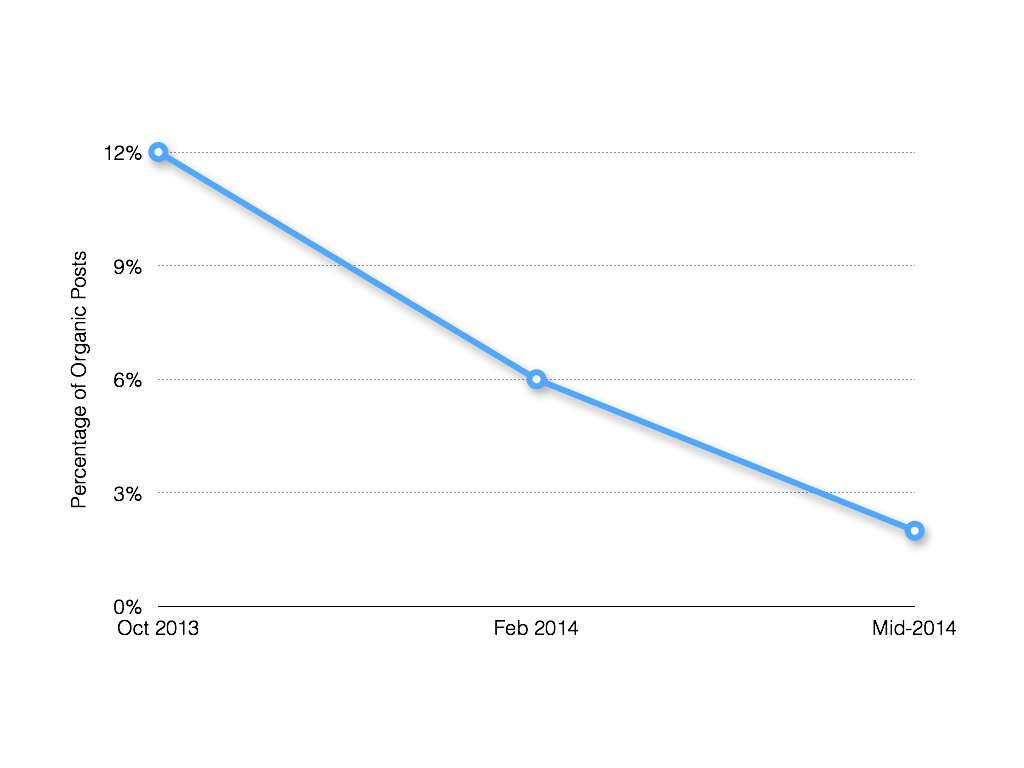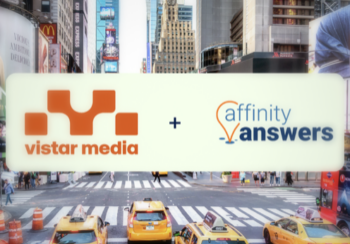Facebook Strategic Shift: The Importance of Social Affinities in a Pay-to-Play Environment
Big changes are underway at Facebook — ones you should know about if you rely on Facebook for reaching your fans. These changes are discussed in detail in a new whitepaper, “The New Facebook Strategic Shift: Reach & Frequency Model,” just published by social media marketing agencies Fanscape and The Marketing Arm. The report’s author, Tom Edwards, keeps a close eye on Facebook, and his study is comprehensive about the ways that Facebook is shifting to a model built much less around organic reach and much more around “pay to play.”
The Death of Facebook Page “Likes”
In a nutshell, Facebook is moving away from community-driven engagement model for brands and their fans. Instead, they intend to be what Edwards calls an “extremely well-targeted media platform,” one that will serve as another paid advertising channel for advertisers. We’ll talk about more of the implications in a minute, but the overall effect will be to reduce the impact of earned media on Facebook.
With this change, Facebook is essentially saying that having Facebook users click “Like” to follow your page is no longer as relevant for reaching your audience, because those fans simply won’t see as many of your posts unless you pay for advertising on the platform. In past years, the organic reach of your content to the people who had “Liked” your page was up in the range of 16%. Even last autumn, it was around 12% That number has dropped and dropped; as “The New Facebook Strategic Shift” makes clear, it will soon be below 2%.

There’s nothing wrong with this change per se, even if some analysts have used provocative terms like “swindle” to describe it. As Edwards points out, Facebook is a publicly traded company with a vested interest in increasing its revenue and profits. Advertising is a primary way for Facebook to achieve that, since it remains a free service for users — who, of course, gladly spend countless millions of hours on the platform every day to keep track of people, organizations, and brands they care about.
What Brand Marketers Need to Know about Reaching Their Facebook Audience
This change does, however, have profound implications for brands and entertainment companies that use Facebook to reach their fans. In the past, you’ve probably focused on getting people to “Like” your page if they have an interest in your brand. You knew they wouldn’t see everything you posted, but you also knew they would have good exposure to your content, which they could then react to by “Liking” a post, commenting on it, or sharing it on their own timelines.
Now, though, that dynamic has changed, and in general getting people to “Like” your page is not nearly as important. Edwards goes through a list of things you should do instead to take advantage of Facebook’s stronger orientation to advertising. Based on his conversations with Facebook itself, he suggests that marketers:
- Improve Creative. If you want your promoted content on Facebook to attract attention, you’re going to have to up your game.
- Change Post Frequency. Rather than posting as much, you should focus on posting better content and reiterating it artfully across multiple niches of your audience.
- Personalize and Segment. Now more than ever, you need to find the right fans at the right time with your content.
- Optimize. Fair is fair: Edwards wants to tout his agency’s expertise, so here he touches on its ability to help companies create better content.
Doing these four things should help brands improve their reach and resonance, which are the themes that Facebook itself is emphasizing for its advertisers.
The Role of Social Affinities on Facebook
There’s a key angle of Edwards’ analysis that resonates particularly with us at Affinity Answers, and that’s the promotion of organic reach through word of mouth, especially around user-generated content (UGC). Even though Facebook is de-emphasizing earned media, it’s still possible — and worthwhile — to cultivate great word of mouth sharing on Facebook.
We’ve been studying the social affinities of Facebook users for years. We’ve seen many examples of how affinity analysis can help our client companies in TV broadcasting and other industries find their best fans and align the right content to them.
Understanding social affinities can help you understand what kind of content to develop, and which behaviors your fans are most likely to engage in as they respond to it. (Bonus: our work applies across both Twitter and Facebook, so you can balance your content efforts across the two biggest social platforms.) All of this can boost your word-of-mouth and other organic efforts, even under Facebook’s new setup.
Social affinities also have an impact on Facebook ad targeting. Our clients who have chosen ad keywords and targeted audience niches based on social affinities have reaped much higher response rates and much lower cost-per-click, which allows them to get the most bang for their Facebook advertising buck. That’s more important than ever as Facebook shifts to its new ad-centered marketing model for brands.
The floor is open: How do you think Facebook’s new approach will affect your brand?



I don’t think the title of your article matches the content lol. Just kidding, mainly because I had some doubts after reading the article.
Thanks for sharing. I read many of your blog posts, cool, your blog is very good.
Your article helped me a lot, is there any more related content? Thanks!
Velocidad critica
Aparatos de balanceo: importante para el operación suave y óptimo de las equipos.
En el ámbito de la avances moderna, donde la rendimiento y la estabilidad del aparato son de alta relevancia, los sistemas de equilibrado juegan un papel vital. Estos equipos específicos están desarrollados para calibrar y fijar partes rotativas, ya sea en maquinaria de fábrica, medios de transporte de transporte o incluso en aparatos domésticos.
Para los especialistas en mantenimiento de aparatos y los profesionales, trabajar con sistemas de calibración es crucial para promover el operación fluido y seguro de cualquier mecanismo giratorio. Gracias a estas soluciones tecnológicas modernas, es posible disminuir sustancialmente las movimientos, el zumbido y la esfuerzo sobre los rodamientos, extendiendo la vida útil de elementos costosos.
De igual manera importante es el función que juegan los equipos de ajuste en la asistencia al consumidor. El soporte técnico y el conservación constante usando estos equipos permiten ofrecer prestaciones de excelente estándar, mejorando la bienestar de los clientes.
Para los responsables de proyectos, la aporte en estaciones de equilibrado y sensores puede ser fundamental para optimizar la rendimiento y rendimiento de sus aparatos. Esto es particularmente relevante para los emprendedores que gestionan pequeñas y intermedias negocios, donde cada detalle es relevante.
Asimismo, los sistemas de balanceo tienen una amplia utilización en el ámbito de la prevención y el supervisión de calidad. Facilitan detectar potenciales fallos, evitando reparaciones onerosas y perjuicios a los aparatos. Además, los información generados de estos equipos pueden aplicarse para maximizar sistemas y potenciar la presencia en buscadores de consulta.
Las zonas de utilización de los dispositivos de balanceo abarcan numerosas ramas, desde la manufactura de ciclos hasta el supervisión de la naturaleza. No influye si se refiere de enormes manufacturas de fábrica o modestos talleres domésticos, los dispositivos de equilibrado son esenciales para asegurar un desempeño óptimo y sin fallos.
https://naveridbuy.exblog.jp/35878157/
https://viastoer.blogspot.com/2024/10/5.html
https://umber-iris-dd3cm2.mystrikingly.com/blog/0199e293190
https://ocher-cat-dd3cmm.mystrikingly.com/blog/f6aa48fdc0c
https://ko.anotepad.com/note/read/w8ms52pm
https://ko.anotepad.com/note/read/qscmkp7h
https://ko.anotepad.com/note/read/i5gdw3c4
https://medium.com/@nsw5288/%EB%B9%84%EC%95%84%EA%B7%B8%EB%9D%BC-%EA%B5%AC%EB%A7%A4-%ED%9B%84-%ED%9A%A8%EA%B3%BC%EB%A5%BC-%EA%B7%B9%EB%8C%80%ED%99%94%ED%95%98%EB%8A%94-%EB%B0%A9%EB%B2%95-3ce347d9cfdf
https://naveridbuy.exblog.jp/35859399/
https://anyflip.com/homepage/zgpjr
https://medium.com/@nsw5288/%EB%B9%84%EC%95%84%EA%B7%B8%EB%9D%BC-%EA%B5%AC%EB%A7%A4%EC%B2%98-4274ac7c8bd0
https://golden-grape-dd3cml.mystrikingly.com/blog/5cc22257c87
https://xn--w6-o02ik82a9kav54aokmxvc.mystrikingly.com/blog/vs
https://telegra.ph/%EB%B9%84%EC%95%84%EA%B7%B8%EB%9D%BC-%EA%B5%AC%EB%A7%A4-%ED%8C%81-%ED%95%A9%EB%A6%AC%EC%A0%81%EC%9D%B8-%EA%B0%80%EA%B2%A9%EC%97%90-%EA%B5%AC%EC%9E%85%ED%95%98%EB%8A%94-%EB%B2%95-07-23
https://medium.com/@1kelly76/%EB%B9%84%EC%95%84%EA%B7%B8%EB%9D%BC-%EA%B5%AC%EB%A7%A4-%EC%8B%9C-%EC%B2%98%EB%B0%A9%EC%A0%84%EC%9D%B4-%ED%95%84%EC%9A%94%ED%95%9C%EA%B0%80-6dd230d8e4f3
https://tawny-wombat-dd3cmn.mystrikingly.com/blog/78bd149976f
https://golden-grape-dd3cml.mystrikingly.com/blog/e1770688a1d
https://maize-wombat-dd3cms.mystrikingly.com/blog/6f12963a21b
https://xn--fz-hd0jg6f81ltjas9lbns.mystrikingly.com/blog/64c3eab6211
https://xn--w6-hs1izvv81cmb366re3s.mystrikingly.com/blog/30ddffeb537
https://maize-wombat-dd3cms.mystrikingly.com/blog/7
https://ameblo.jp/naveridbuy/entry-12861932226.html
https://xn--jb-o02ik82a9jc69ko8mqkg.mystrikingly.com/blog/39b3893371f
https://xn--w2-hs1izvv81cmb366re3s.mystrikingly.com/blog/038494815b5
https://truthful-tulip-dbgzhv.mystrikingly.com/blog/3151683cc90
https://medium.com/@1kelly76/%EB%B9%84%EC%95%84%EA%B7%B8%EB%9D%BC-%EA%B5%AC%EB%A7%A4-%EC%8B%A0%EB%A2%B0%ED%95%A0-%EC%88%98-%EC%9E%88%EB%8A%94-%EC%98%A8%EB%9D%BC%EC%9D%B8-%EC%95%BD%EA%B5%AD-%EC%B0%BE%EA%B8%B0-58eabe0b8de6